1998 HONDA CIVIC COUPE check engine
[x] Cancel search: check enginePage 214 of 251
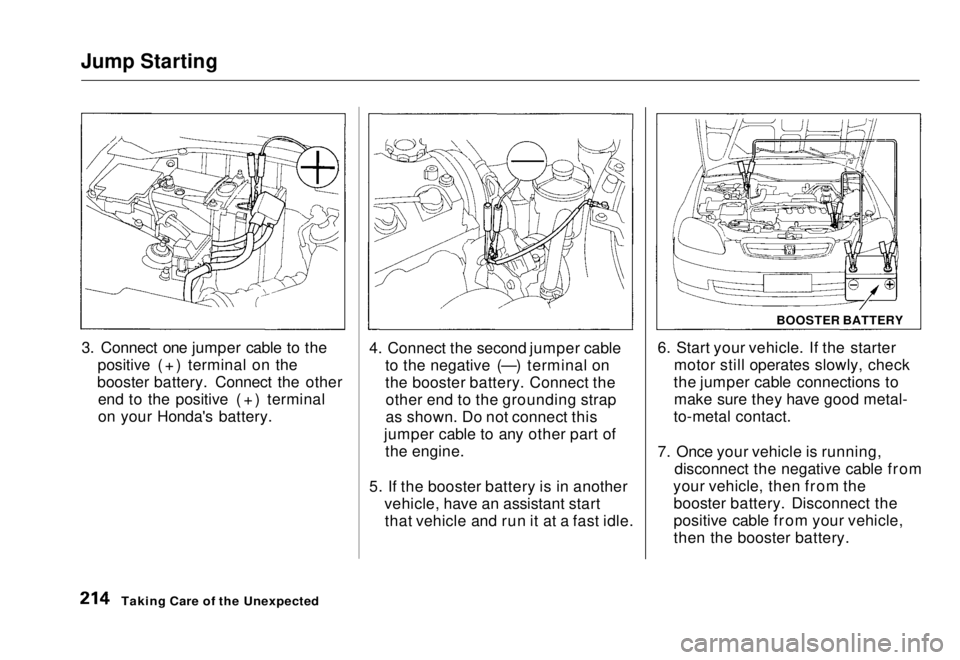
Jump Starting
3. Connect one jumper cable to the positive (+) terminal on the
booster battery. Connect the other end to the positive (+) terminal
on your Honda's battery. 4. Connect the second jumper cable
to the negative (—) terminal on
the booster battery. Connect theother end to the grounding strap
as shown. Do not connect this
jumper cable to any other part of the engine.
5. If the booster battery is in another vehicle, have an assistant startthat vehicle and run it at a fast idle. 6. Start your vehicle. If the starter
motor still operates slowly, check
the jumper cable connections to make sure they have good metal-
to-metal contact.
7. Once your vehicle is running, disconnect the negative cable from
your vehicle, then from the booster battery. Disconnect the
positive cable from your vehicle,
then the booster battery.
Taking Care of the Unexpected
BOOSTER BATTERYMain Menu Table of Contents s t
Page 216 of 251
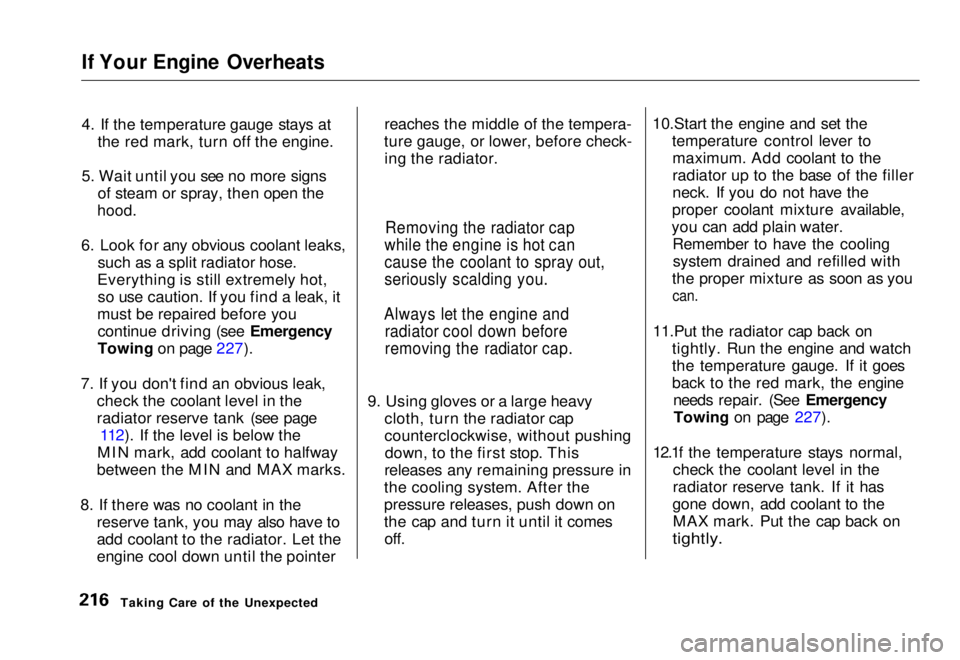
If Your Engine Overheats
4. If the temperature gauge stays at
the red mark, turn off the engine.
5. Wait until you see no more signs of steam or spray, then open the
hood.
6. Look for any obvious coolant leaks, such as a split radiator hose.
Everything is still extremely hot, so use caution. If you find a leak, it
must be repaired before you continue driving (see Emergency
Towing on page 227).
7. If you don't find an obvious leak, check the coolant level in the
radiator reserve tank (see page112). If the level is below the
MIN mark, add coolant to halfway
between the MIN and MAX marks.
8. If there was no coolant in the reserve tank, you may also have to
add coolant to the radiator. Let the
engine cool down until the pointer reaches the middle of the tempera-
ture gauge, or lower, before check- ing the radiator.
9. Using gloves or a large heavy cloth, turn the radiator cap
counterclockwise, without pushingdown, to the first stop. This
releases any remaining pressure in
the cooling system. After the
pressure releases, push down on
the cap and turn it until it comes off. 10.Start the engine and set the
temperature control lever tomaximum. Add coolant to the
radiator up to the base of the filler
neck. If you do not have the
proper coolant mixture available,
you can add plain water. Remember to have the coolingsystem drained and refilled with
the proper mixture as soon as you
can.
11.Put the radiator cap back on tightly. Run the engine and watch
the temperature gauge. If it goes
back to the red mark, the engineneeds repair. (See EmergencyTowing on page 227).
12.1f the temperature stays normal, check the coolant level in the
radiator reserve tank. If it has
gone down, add coolant to the MAX mark. Put the cap back on
tightly.
Taking Care of the Unexpected
Removing the radiator cap
while the engine is hot can
cause the coolant to spray out,
seriously scalding you.
Always let the engine and radiator cool down before
removing the radiator cap.Main Menu Table of Contents s t
Page 217 of 251
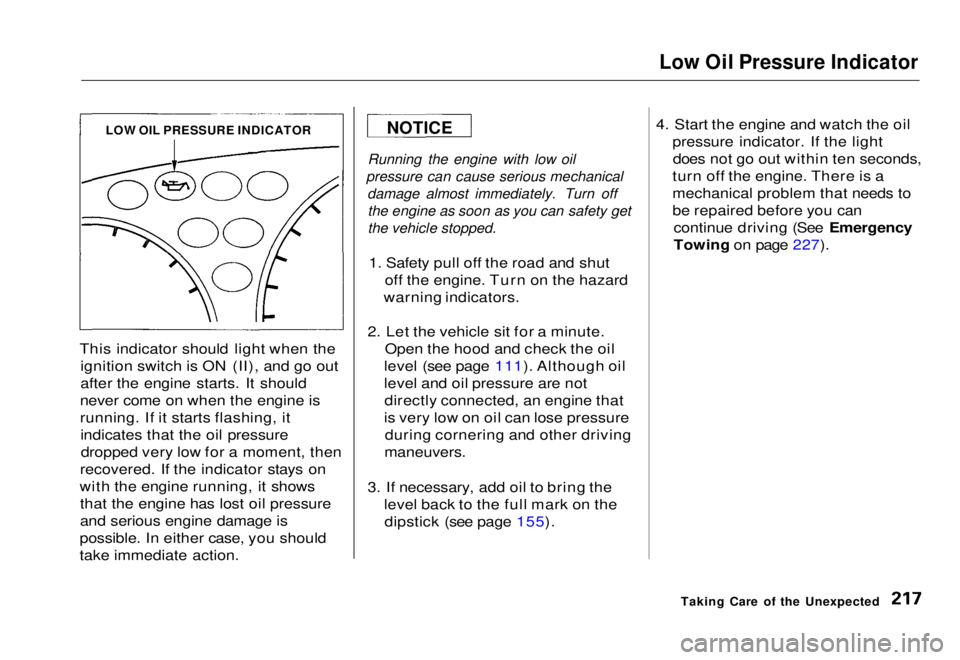
Low Oil Pressure Indicator
This indicator should light when the ignition switch is ON (II), and go out
after the engine starts. It should
never come on when the engine is
running. If it starts flashing, it indicates that the oil pressuredropped very low for a moment, then
recovered. If the indicator stays on
with the engine running, it shows that the engine has lost oil pressure
and serious engine damage is
possible. In either case, you should
take immediate action.
Running the engine with low oil
pressure can cause serious mechanical damage almost immediately. Turn offthe engine as soon as you can safety get
the vehicle stopped.
1. Safety pull off the road and shut off the engine. Turn on the hazard
warning indicators.
2. Let the vehicle sit for a minute. Open the hood and check the oil
level (see page 111). Although oil
level and oil pressure are not directly connected, an engine that
is very low on oil can lose pressure during cornering and other driving
maneuvers.
3. If necessary, add oil to bring the level back to the full mark on thedipstick (see page 155). 4. Start the engine and watch the oil
pressure indicator. If the lightdoes not go out within ten seconds,
turn off the engine. There is a
mechanical problem that needs to
be repaired before you can continue driving (See Emergency
Towing on page 227).
Taking Care of the Unexpected
LOW OIL PRESSURE INDICATOR
NOTICEMain Menu Table of Contents s t
Page 219 of 251
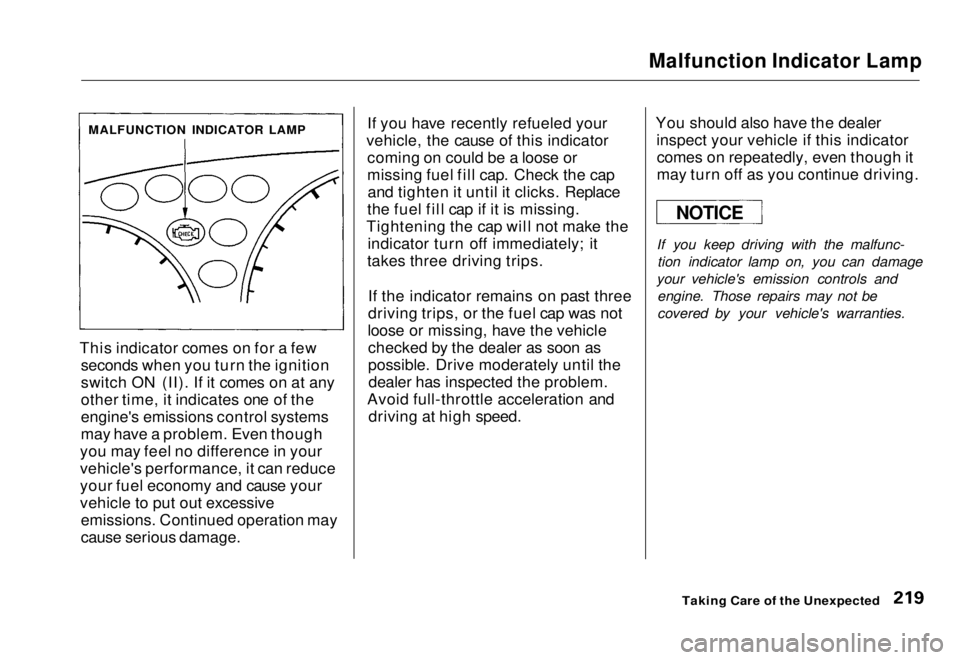
Malfunction Indicator Lamp
This indicator comes on for a few seconds when you turn the ignition
switch ON (II). If it comes on at any
other time, it indicates one of the
engine's emissions control systems
may have a problem. Even though
you may feel no difference in your
vehicle's performance, it can reduce
your fuel economy and cause your
vehicle to put out excessive emissions. Continued operation may
cause serious damage. If you have recently refueled your
vehicle, the cause of this indicator coming on could be a loose or
missing fuel fill cap. Check the capand tighten it until it clicks. Replace
the fuel fill cap if it is missing.
Tightening the cap will not make the indicator turn off immediately; it
takes three driving trips.
If the indicator remains on past three
driving trips, or the fuel cap was not
loose or missing, have the vehicle checked by the dealer as soon as
possible. Drive moderately until thedealer has inspected the problem.
Avoid full-throttle acceleration and driving at high speed. You should also have the dealer
inspect your vehicle if this indicatorcomes on repeatedly, even though it
may turn off as you continue driving.
If you keep driving with the malfunc- tion indicator lamp on, you can damage
your vehicle's emission controls and engine. Those repairs may not be
covered by your vehicle's warranties.
Taking Care of the Unexpected
MALFUNCTION INDICATOR LAMP
NOTICEMain Menu Table of Contents s t
Page 223 of 251
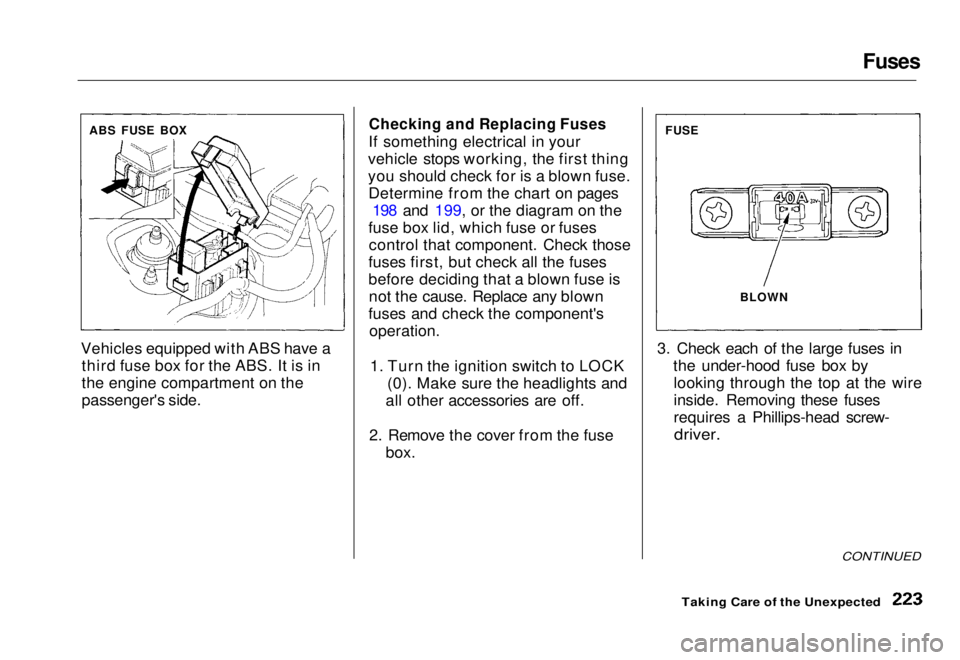
Fuses
Vehicles equipped with ABS have a third fuse box for the ABS. It is in
the engine compartment on the
passenger's side.
Checking and Replacing Fuses
If something electrical in your
vehicle stops working, the first thing
you should check for is a blown fuse. Determine from the chart on pages 198 and 199, or the diagram on the
fuse box lid, which fuse or fuses control that component. Check those
fuses first, but check all the fuses
before deciding that a blown fuse is not the cause. Replace any blown
fuses and check the component's
operation.
1. Turn the ignition switch to LOCK (0). Make sure the headlights and
all other accessories are off.
2. Remove the cover from the fuse box. 3. Check each of the large fuses in
the under-hood fuse box bylooking through the top at the wire
inside. Removing these fuses
requires a Phillips-head screw-
driver.
CONTINUED
Taking Care of the Unexpected
ABS FUSE BOX
FUSE
BLOWNMain Menu Table of Contents s t
Page 247 of 251
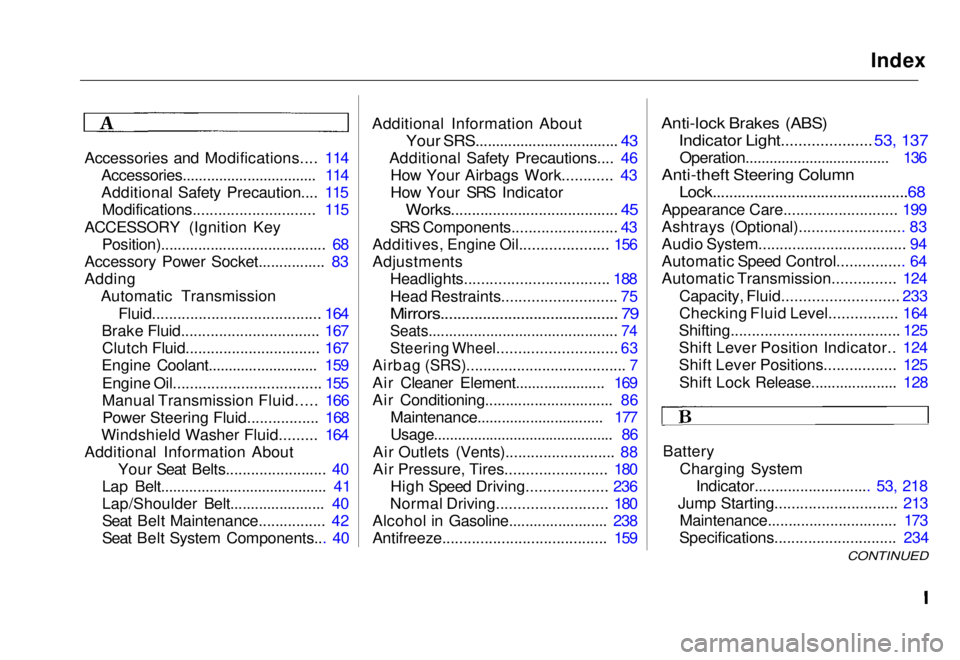
Index
Accessories and Modifications.... 114 Accessories................................. 114
Additional Safety Precaution.... 115Modifications............................. 115
ACCESSORY (Ignition Key Position)........................................ 68
Accessory Power Socket................ 83
Adding Automatic Transmission
Fluid........................................ 164
Brake Fluid................................. 167 Clutch Fluid................................ 167
Engine Coolant........................... 159
Engine Oil................................... 155
Manual Transmission Fluid..... 166Power Steering Fluid................. 168
Windshield Washer Fluid......... 164
Additional Information About Your Seat Belts........................ 40
Lap Belt......................................... 41
Lap/Shoulder Belt....................... 40
Seat Belt Maintenance................ 42
Seat Belt System Components... 40 Additional Information About
Your SRS................................... 43
Additional Safety Precautions.... 46 How Your Airbags Work............ 43
How Your SRS Indicator
Works........................................ 45
SRS Components......................... 43
Additives, Engine Oil..................... 156
Adjustments
Headlights.................................. 188
Head Restraints........................... 75
Mirrors.......................................... 79
Seats.............................................. 74
Steering Wheel............................ 63
Airbag (SRS)...................................... 7
Air Cleaner Element...................... 169
Air Conditioning............................... 86 Maintenance............................... 177
Usage............................................. 86
Air Outlets (Vents).......................... 88
Air Pressure, Tires........................ 180 High Speed Driving................... 236
Normal Driving.......................... 180
Alcohol in Gasoline........................ 238
Antifreeze....................................... 159
Anti-lock Brakes (ABS)
Indicator Light.....................
53, 137
Operation.................................... 13 6
Anti-thef
t Steering Column
Lock...............................................68
Appearance Care........................... 199
Ashtrays (Optional)......................... 83
Audio System................................... 94
Automatic Speed Control................ 64
Automatic Transmission............... 124
Capacity, Fluid........................... 233
Checking Fluid Level................ 164
Shifting........................................ 125
Shift Lever Position Indicator.. 124
Shift Lever Positions................. 125
Shift Lock Release..................... 128
Battery Charging SystemIndicator............................ 53,
218
Jump Starting............................ .
213
Maintenance............................... 173
Specifications............................. 234
CONTINUEDMain Menu s t
Page 248 of 251
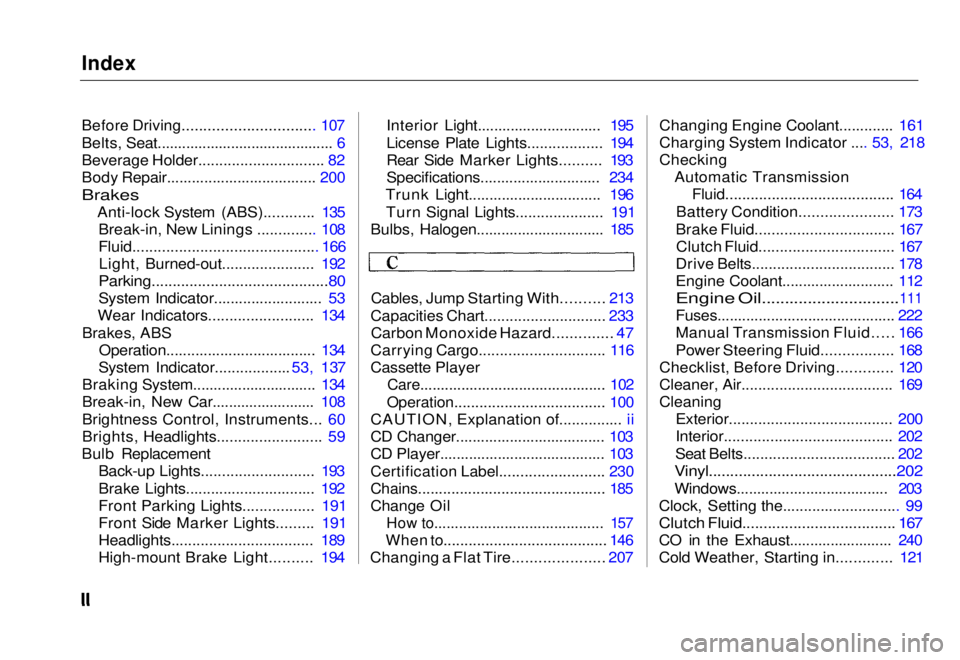
Index
Before Driving............................... 107
Belts, Seat........................................... 6
Beverage Holder.............................. 82
Body Repair.................................... 200
Brakes
Anti-lock System (ABS)............ 135Break-in, New Linings .............. 108
Fluid............................................ 166Light, Burned-out...................... 192
Parking..........................................80
System Indicator.......................... 53
Wear Indicators......................... 134
Brakes, ABS Operation.................................... 134
System Indicator..................
53, 13 7
Braking System............................. .
134
Break-in, New Car......................... 108
Brightness Control, Instruments... 60
Brights, Headlights......................... 59
Bulb Replacement Back-up Lights........................... 193
Brake Lights............................... 192
Front Parking Lights................. 191
Front Side Marker Lights......... 191
Headlights.................................. 189
High-mount Brake Light.......... 194 Interior Light.............................. 195
License Plate Lights.................. 194
Rear Side Marker Lights.......... 193
Specifications............................. 234
Trunk Light................................ 196
Turn Signal Lights..................... 191
Bulbs, Halogen............................... 185
Cables, Jump Starting With.......... 213
Capacities Chart............................. 233 Carbon Monoxide Hazard.............. 47
Carrying Cargo.............................. 116
Cassette Player
Care............................................. 102
Operation.................................... 100
CAUTION, Explanation of............... ii
CD Changer.................................... 103
CD Player........................................ 103
Certification Label......................... 230
Chains............................................. 185
Change Oil
How to......................................... 157
When to....................................... 146
Changing a Flat Tire..................... 207 Changing Engine Coolant............. 161
Charging System Indicator .... 53,
218
Checking
Automatic Transmissio
n
Fluid........................................ 164
Battery Condition...................... 173
Brake Fluid................................. 167
Clutch Fluid................................ 167
Drive Belts.................................. 178
Engine Coolant........................... 112
Engine Oil..............................
111
Fuses........................................... 22 2
Manua
l Transmission Fluid..... 166
Power Steering Fluid................. 168
Checklist, Before Driving............. 120
Cleaner, Air.................................... 169
Cleaning Exterior....................................... 200
Interior........................................ 202
Seat Belts.................................... 202
Vinyl............................................202
Windows..................................... 203
Clock, Setting the............................ 99
Clutch Fluid.................................... 167
CO in the Exhaust......................... 240
Cold Weather, Starting in............. 121Main Menu s t
Page 249 of 251
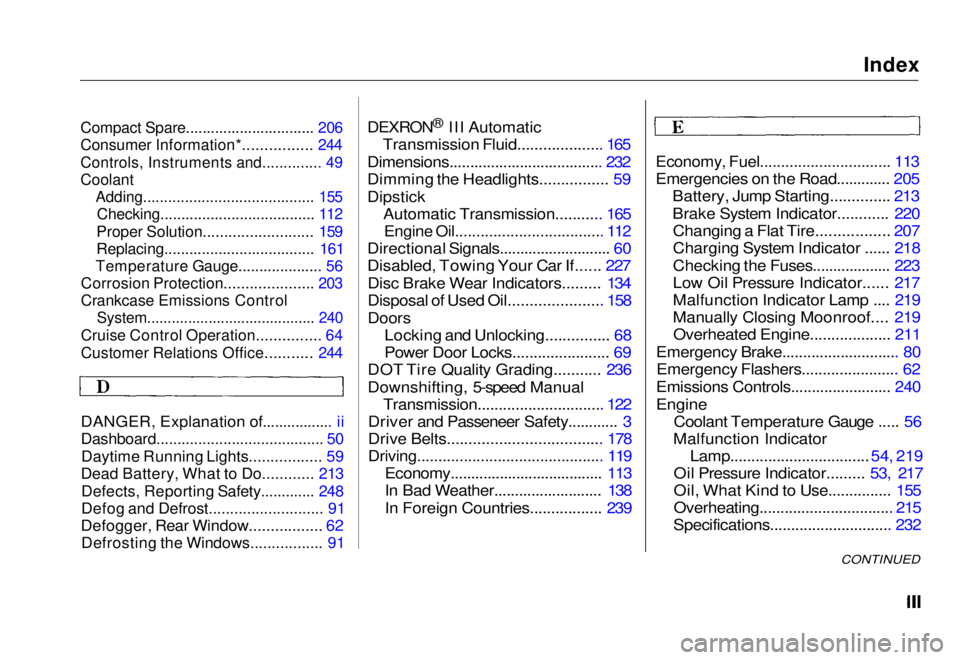
Index
Compact Spare............................... 206
Consumer Information*................ 244
Controls, Instruments and.............. 49
Coolant
Adding......................................... 155
Checking..................................... 112
Proper Solution.......................... 159
Replacing.................................... 161
Temperature Gauge.................... 56
Corrosion Protection..................... 203
Crankcase Emissions Control
System......................................... 240
Cruise Control Operation............... 64
Customer Relations Office........... 244
DANGER, Explanation of................. ii
Dashboard........................................ 50
Daytime Running Lights................. 59
Dead Battery, What to Do............ 213
Defects, Reporting Safety............. 248
Defog and Defrost........................... 91
Defogger, Rear Window................. 62
Defrosting the Windows................. 91
DEXRON
®
III Automatic
Transmission Fluid.................... 165
Dimensions..................................... 232
Dimming the Headlights................ 59
Dipstick Automatic Transmission........... 165
Engine Oil................................... 112
Directional Signals........................... 60
Disabled, Towing Your Car If...... 227
Disc Brake Wear Indicators......... 134
Disposal of Used Oil...................... 158
Doors
Locking and Unlocking............... 68
Power Door Locks....................... 69
DOT Tire Quality Grading........... 236
Downshifting, 5-speed Manual Transmission.............................. 122
Driver and Passeneer Safety............ 3
Drive Belts.................................... 178
Driving............................................ 119
Economy..................................... 113
In Bad Weather.......................... 138
In Foreign Countries................. 239
Economy, Fuel............................... 113
Emergencies on the Road............. 205
Battery, Jump Starting.............. 213
Brake System Indicator............ 220Changing a Flat Tire................. 207
Charging System Indicator ...... 218
Checking the Fuses................... 223
Low Oil Pressure Indicator...... 217
Malfunction Indicator Lamp .... 219
Manually Closing Moonroof.... 219Overheated Engine................... 211
Emergency Brake............................ 80 Emergency Flashers....................... 62
Emissions Controls........................ 240
Engine
Coolant Temperature Gauge ..... 56
Malfunction Indicator
Lamp.................................
54, 219
Oil Pressur e
Indicator......... 53,
217
Oil, Wha
t
Kind to Use............... 155
Overheating................................ 215
Specifications............................. 232
CONTINUEDMain Menu s t